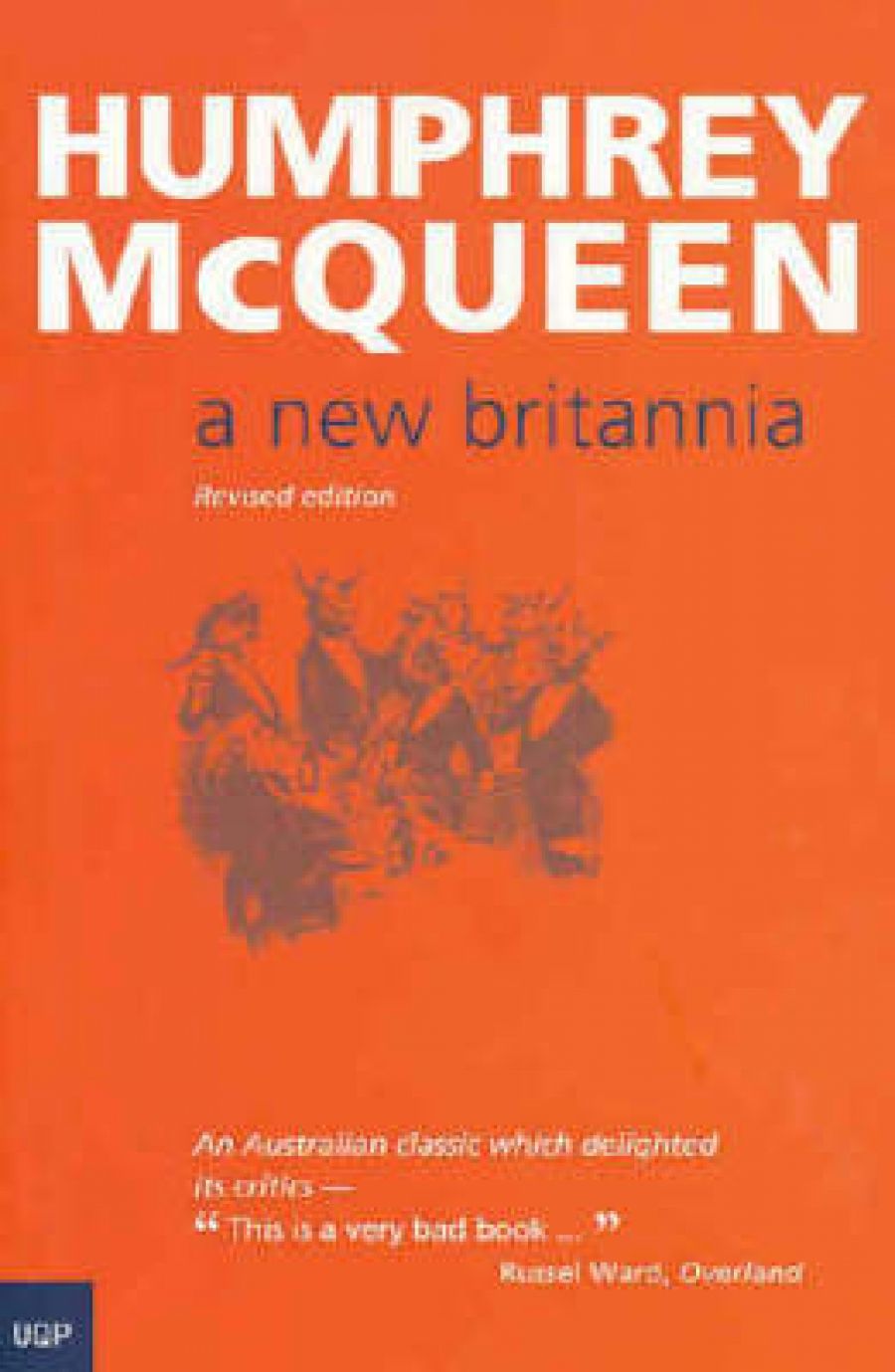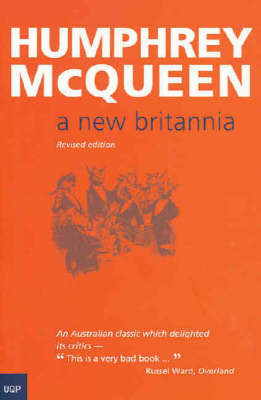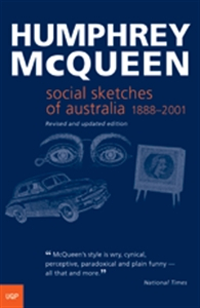
- Free Article: No
- Contents Category: History
- Review Article: Yes
- Article Title: Sergeant Humphrey
- Online Only: No
- Custom Highlight Text:
There must be few Australian history books that have run to a fourth edition, and it’s hard to think of any that have provoked as much discussion – and rancour – as Humphrey McQueen’s ‘New Left’ classic A New Britannia. It’s the Sergeant Pepper of Australian historiography: racy, emblematic of its time and place, and full of special effects – the impolite may call some of them recording tricks. Does it still have the capacity to shock the first-time reader, as it did me when I encountered it as an undergraduate in the 1980s? Perhaps, having been bred on so many of the legends to which McQueen laid waste, I was just very shockable. Like a lot of readers, I had never imagined Henry Lawson as a fascist.
- Book 1 Title: A New Britannia
- Book 1 Subtitle: Fourth Edition
- Book 1 Biblio: UQP, $24.95 pb, 336 pp
- Book 1 Cover Small (400 x 600):

- Book 1 Cover (800 x 1200):

- Book 2 Title: Social Sketches of Australia
- Book 2 Subtitle: Third Edition
- Book 2 Biblio: UQP, $24.95 pb, 430 pp
- Book 2 Cover Small (400 x 600):

- Book 2 Cover (800 x 1200):

The blurb on the front cover of this fourth edition gives only a hint of the responses that the original 1970 Penguin paperback evoked, especially and ironically on the left: ‘An Australian classic which delighted its critics – "This is a very bad book..." Russel Ward, Overland.’ A glance at Ward’s original review – in fact, I have in front of me Ward’s own copy of Overland – provides a better indication of the bitterness it aroused in some quarters. ‘Rational debate is impossible with one who has taken to himself the divine attribute of omniscience,’ pronounced Ward, although his was by no means the most scathing indictment of A New Britannia. A large part of the author’s ‘problem’ was that he had broken the rule of polite academic engagement. ‘Old Left’ historians such as Ward, he said. presented ‘a once radical people’ who had gone into decline; it was the historians who had declined, thought McQueen.
A New Britannia emphasised the racism, militarism and petit-bourgeois acquisitiveness in Australia ‘s past. The daddy of all ‘black armband’ histories, it largely set Australian history’s agenda for the next twenty years. McQueen now describes A New Britannia as ‘a book with the wind in its sails’: Vietnam,’1968’ and so on. His approach to the history of Australia’s working class owed much to E.P. Thompson’s classic The Making of the English Working Class (1963), but I am inclined to make a less obvious comparison – even less obvious, perhaps, than Sergeant Pepper. When A.J.P. Taylor’s The Origins of the Second World War was published in 1961, its impact among readers in Harold Macmillan’s Britain was rather like a V-2 Rocket landing on a parsonage garden party. Even if you didn’t quite believe that you had never had it so good, you could at least draw the lesson from the piles of B-grade war movies with which you were being bombarded that World War II had been Britain’s finest hour, that England had fought a ‘people’s war’ to defend freedom and civilisation, that the appeasers were naive and wrong, and Churchill right. Taylor would have none of it; Britain went to war in 1939 for far less noble reasons.
If the oft-heard claim that Australia’s 1960s really happened in the 1970s is correct, A New Britannia, like Taylor’s book, appeared at the beginning of the 1960s. And again, like Taylor’s Origins, it subjected to rough handling a number of comforters which had been as important to the Australian left as to the RSL-cum-Country Party right. Australia in 1970 was riding the crest of the minerals boom and Vietnam was only beginning to shatter post-Menzian national complacency. It had never had it so good, and it’s not hard to see why McQueen was such a powerful irritant in these circumstances. Yet it is also difficult to overlook his prescience and continuing relevance: his claim in the ‘Invaders’ chapter that Australian were prone to a siege mentality’ would come as no shock to observers of the ‘certain maritime incidents’ of recent times while the conservative potential of the Australian legend that McQueen recognised has, as shown by Judith Brett, been fully realised by John Howard.
McQueen has added a new afterword to this edition of A New Britannia, reflecting his research on the development of modern capitalism and globalisation, but there has been no dramatic revision of the 1970 text in subsequent editions.
After all, A New Britannia is a ‘classic’; Social Sketches, on the other hand, which he has substantially revised and updated, is not. Yet the latter is an important book because it, in many ways, extends the possibilities for Australian history more radically than A New Britannia. That Australian history might include such topics as the substances that people put in their hair; the food, drink and drugs they consumed; the appliances they used in their homes; even the stories of cow-shit, dung-beetles and flies is all now uncontroversial. But in 1978, when the first edition appeared, Australian social history was at a rather more formative stage.
Social Sketches then and now is a reminder of just what a remarkably imaginative and adventurous historian McQueen is at his best. Few historians would think to use the postage stamps issued in 1970 to provide a snapshot of Australia’s sense of itself in that year. And how many social historians would consider the different colours in which cars were available in the 1940s and 1950s, or Australians’ preferences in the matter, worthy of comment? (Did you know that by 1958 ‘Ford V-8s came in twelve body colours with sixteen more shades for the flash along the sides’?)
Yet to pluck this kind of comment out of its context actually misrepresents Mc Queen’s approach to the past. Social history with such a wide range can become a very assorted miscellany, with little coherence and nothing in sight even resembling an argument – entertaining in its own way, but revealing little of the dynamics of the past. McQueen prepares his readers for the worst when he says at the outset that he is offering ‘a glimpse of what it has been like to live in Australia since 1888...it is not history in any meaningful sense’. Yet the warning is not justified in this case; this is a very meaningful history.
Perhaps McQueen’s modesty about Social Sketches is a deliberate effort to provoke readers into revising their sense of what history is about, and what is important in Australia’s past. There are plenty of indications in the text itself that this is a part of McQueen’s purpose. As he remarks in the final section: ‘The contraceptive pill and hire purchase have done as much to alter the way Australians live now as did the Anzacs on Gallipoli or the striking shearers around Barcaldine in 1891.’ He ends this fine book with a discussion of Alec Campbell, ‘The Last Anzac’, in which McQueen reminds us that Campbell was also an unofficial bodyguard for radical Labor Senator Bill Morrow. ‘Should Campbell be remembered for his brief military service or his lifelong radicalism?’ asks McQueen. His answer is clearly both, but all the same, Social Sketches deals more fully with some aspects of everyday life than others. McQueen has little to say about sport or religion, but even without the illustrations that have been removed from this edition Social Sketches remains unsurpassed as a social history of the long twentieth century in Australia.


Comments powered by CComment